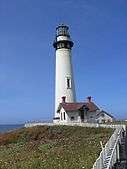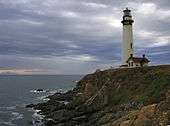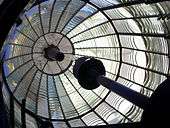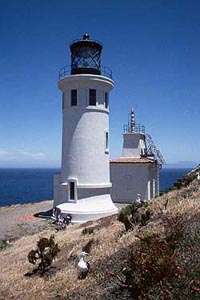Pigeon Point Lighthouse
 Pigeon Point Lighthouse from the north | |
 California | |
| Location |
Pigeon Point southern to San Francisco Bay California United States |
|---|---|
| Coordinates | 37°10′54.3″N 122°23′38.1″W / 37.181750°N 122.393917°WCoordinates: 37°10′54.3″N 122°23′38.1″W / 37.181750°N 122.393917°W |
| Year first constructed | 1871 |
| Year first lit | 1872 |
| Automated | 1974 |
| Foundation | stone |
| Construction | brick tower |
| Tower shape | tapered cylindrical tower with balcony and lantern attached to workroom |
| Markings / pattern | white tower, black trim |
| Height | 115 ft (35 m) |
| Focal height | 148 ft (45 m) |
| Original lens | First order Fresnel lens (1872) |
| Current lens | DCB-24 aerobeacon |
| Range | 24 nmi (44 km; 28 mi) |
| Characteristic | Flashing white 10s, Emergency light of reduced intensity when main light is extinguished. |
| Admiralty number | G4006 |
| ARLHS number | USA-499 |
| USCG number | 6-0320 |
| Managing agent | Pigeon Point Lighthouse State Historic Park[1][2] |
| Designated | 1977 |
| Reference no. | 77000337[3] |
| Designated | 1980 |
| Reference no. | 930[4] |
Pigeon Point Light Station or Pigeon Point Lighthouse is a lighthouse built in 1871 to guide ships on the Pacific coast of California. It is the tallest lighthouse (tied with Point Arena Light) on the West Coast of the United States. It is still an active Coast Guard aid to navigation. Pigeon Point Light Station is located on the coastal highway (State Route 1), 5 miles (8 km) south of Pescadero, California, between Santa Cruz and San Francisco. The 115-foot (35 m), white masonry tower, resembles the typical New England structure. Because of its location and ready access from the main highway, Pigeon Point entertains a large number of public visitors.
The lighthouse and the land around have been preserved as Pigeon Point Light Station State Historic Park, a California state park. The lighthouse is also listed on the National Register of Historic Places,[3] and designated as a California Historical Landmark.[4]
The Pigeon Point Lighthouse is also a logo of E. W. Scripps Company.
History

Pigeon Point Lighthouse is one of the most picturesque lighthouses on the Pacific coast. The tower stands on a rocky promontory and has long been a landmark for ships approaching San Francisco Bay from the south. This headland, and hence the lighthouse, took its name from the ship Carrier Pigeon that wrecked here in 1853.
The lantern room of the tower is no longer equipped with the original first-order, 1000-watt Fresnel lens.[5] No longer illuminated for demonstration purposes,[6] the lens has 24 flash panels, is composed of 1008 hand-polished lenses and prisms and is capable of producing over 500,000 candlepower illumination. It was manufactured by the Henry-LePaute company in Paris, France and was first lit at Pigeon Point at sunset on November 15, 1872.
Originally the tower was equipped with a lamp that burned refined lard oil (pig fat). In 1888, that lamp was replaced with a mineral oil (kerosene) lamp. To produce Pigeon Point's assigned characteristic of one white flash of light every ten seconds, the one (1) ton lens rotated one time every four minutes. When observed from a distance, this resulted in the appearance of one white flash of light every ten seconds. The lens rotation was originally powered by a clockworks and 45 pounds (20 kg) weight. In 1926 the lighthouse was provided with electricity. Modern innovations were incorporated and the kerosene IOV lamp was replaced by a 1000 watt bulb, the clockworks by an electric motor and an electrically operated fog signal was eventually installed. The lighthouse has been designated California Historical Landmark number 930. In 1972, the United States Coast Guard mounted a 24-inch (610 mm) aerobeacon on the front of the tower (now replaced by a smaller beacon) and officially retired the Fresnel lens from regular duty. The First order Fresnel lens is no longer lit to celebrate special occasions, such as the annual lighting of the lens, which usually occurred in mid-November (closest Saturday to November 15) the date of the original first lighting in 1872. The lens was removed from the top of the tower in November 2011, to now be displayed in the fog signal building, adjacent to the base of the lighthouse. The light outside the lens room, mounted on a small verandah at the top of the 100-foot (30 m) tower, rotating with six beams, is still an active aid to navigation. Updated information, garnered from the recent lens removal crew, has produced new numbers for the weight of the lens...long reported to be four tons. In actuality that figure was the complete shipping weight of the lens and its rotating clock works. The correct figures are as follows: lens weight, one (1) ton; the clock works, one (1) ton; and the seventy-eight (78) wooden shipping crates to contain such, two (2) tons; total, therefore, being the reported four tons.
The tower has been closed to tours since December 2001 because of the collapse of brickwork supporting outside access metal walkways on the top of the structure. Cast iron was used rather than steel with the unfortunate result being that cast iron absorbs water rather than repelling it like steel, thus the walkways are severely rusted, as are the major binding ring bands at the base of the tower! The California State Park system has promised repairs, but it is estimated that even if funds were available, it would be seven to ten years before the repairs would be completed. In July, 2010, Rep. Anna G. Eshoo (D-Palo Alto) stated that of the $3.4 million she requested for her district through the Fiscal Year 2011 Interior and Environment Appropriations Act, $250,000 will be allocated to restore the upper portion of the lighthouse.[7]
The restored lighthouse keepers' housing has, since the mid-1960s, also served as a youth hostel for travelers. The hostel is operated by the Golden Gate Council of Hostelling International.[8] The four three-bedroom houses by the lighthouse have overnight lodging for up to 50 people of all ages. Each house has male or female bunk rooms. Separate bunk rooms can be reserved for families or couples. Hostel guests share bathrooms, kitchens and living rooms. An outdoor hot tub can be rented in the evenings.
Image gallery
 Pigeon Point, ca. 1870s, prior to construction
Pigeon Point, ca. 1870s, prior to construction- U.S. Coast Guard archive photo
 Taken circa 1950 when fully operational including the Fresnel lens and fog signal
Taken circa 1950 when fully operational including the Fresnel lens and fog signal Pigeon Point Lighthouse with light on
Pigeon Point Lighthouse with light on On pacific coast in summer
On pacific coast in summer Pigeon Point Lighthouse with wildflowers (view from the South)
Pigeon Point Lighthouse with wildflowers (view from the South)

 Pigeon Point Light Station: Inside View of the Fresnel Lens
Pigeon Point Light Station: Inside View of the Fresnel Lens Pigeon Point Light Station Stairs in the Tower
Pigeon Point Light Station Stairs in the Tower Pigeon Point Lighthouse Hostel
Pigeon Point Lighthouse Hostel
See also
References
- ↑ The Lighthouse Directory. University of North Carolina at Chapel Hill. Retrieved 12 June 2016
- ↑ California Historic Light Station Information & Photography United States Coast Guard. Retrieved 12 June 2016
- 1 2 National Park Service (2010-07-09). "National Register Information System". National Register of Historic Places. National Park Service.
- 1 2 "Pigeon Point Lighthouse". Office of Historic Preservation, California State Parks. Retrieved 2012-10-14.
- ↑ Santa Cruz Sentinel - Once majestic Pigeon Point Lighthouse - a legendary landmark - now in need of major restoration
- ↑ Nemiroff, R.; Bonnell, J., eds. (26 November 2007). "Moon Over Pigeon Point Lighthouse". Astronomy Picture of the Day. NASA.
- ↑ Hmbreview.com
- ↑ Hiusa.org
Further reading
- California Department of Parks and Recreation (2002). Pigeon Point Light Station State Historic Park. Sacramento, CA: California State Parks. OCLC 56543458.
- Perry, Frank (1986). The history of Pigeon Point Lighthouse. Soquel, CA: GBJ Pub. ISBN 978-0-943896-02-1.
- Perry, Frank (Spring 1999). "Legacy of the Carrier Pigeon - A History of the Pigeon Point Light Station". The Keeper's Log. United States Lighthouse Society. XV (3).
- Semones, JoAnn (2007). Shipwrecks, scalawags, and scavengers: the storied waters of Pigeon Point. Palo Alto, CA: Glencannon Press/Maritime Books. ISBN 978-1-889901-42-8.
External links
| Wikimedia Commons has media related to Pigeon Point Lighthouse. |
- United States Coast Guard
- Pigeon Point Light Station State Historic Park
- Carrier Pigeon / CINMS Shipwreck Database
- Lighthouse Friends / Pigeon Point History
- Westkueste USA: Pigeon Point Light House History and description of the Pigeon Point Lighthouse with pictures (German)
